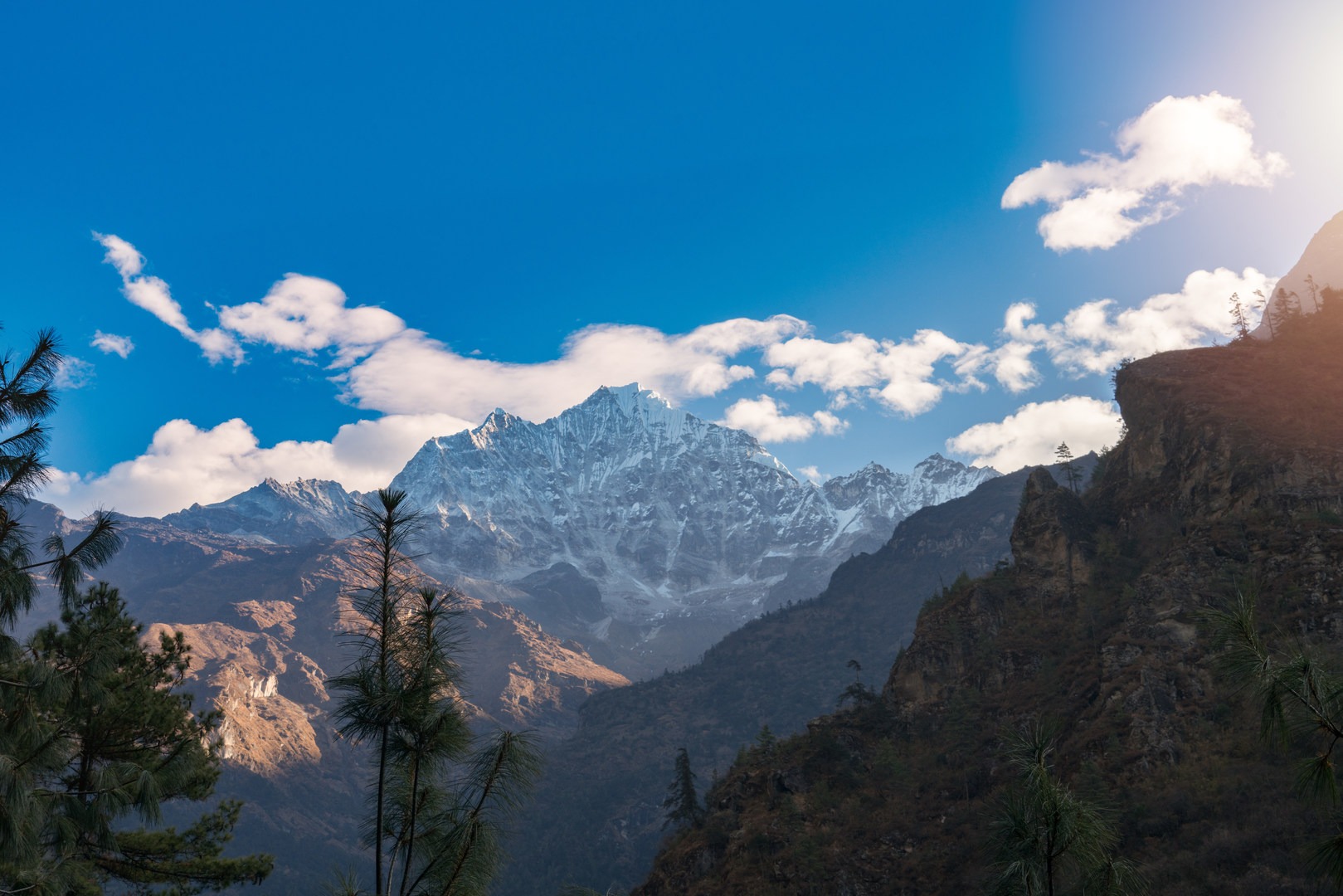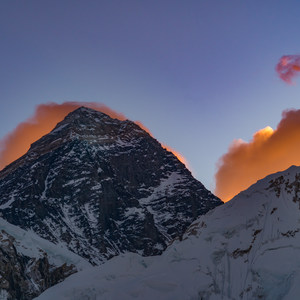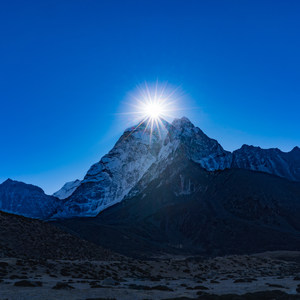You are here
The trail to Everest Base Camp is approximately 110 kilometers (70 miles) there-and-back, not including any additional day trips or side excursions. In many places the trail is wide and well-worn because it is shared by yak-herders whose convoys help to transport valued resources up the valleys. The trail is incredibly dusty and accumulates trash during the busy seasons. Of the many ups and downs, most of the dramatic elevation gains and losses are dealt with through switchbacks and rock stairs. The many river crossings use steel cable suspension bridges that dangle high above the rushing torrents below and make for some scenic, albeit frightening, traverses. The trail passes through diverse ecosystems, from rhododendron forests to alpine scrub, glacial moraines, and some of the tallest mountains on Earth. It is here that the rich culture of the Khumbu Valley can also be witnessed as trekkers pass Buddhist temples, stupas, chortens, and prayer stones.
Although the trail itself is not difficult, the altitude makes hiking quite challenging, even for experienced trekkers. Trekking at such high altitude takes time in order to maximize one's chances of reaching base camp. Guiding companies usually offer anywhere between a 10- and 14-day trekking itinerary depending on the skills and needs of clients. Some prefer to add a loop to the nearby "Three High Passes" of Kongma La (5,535 meters), Cho La (5,420) and Renjo La (5,340 meters), making the route longer and more difficult. Tours via the Gokyo Lakes are also popular for those interested in adding mileage to their EBC trip. Although trekkers are able to choose from countless other itineraries for Everest Base Camp, the 12-day there-and-back is by far the most popular and safest option, allowing for ample acclimitization during the ascent. However, the lower region of the Khumbu does offer some amazing trekking experiences for those not intending to go much higher than Namche Bazaar.
Day 1: Domestic flight from Kathmandu to Lukla (2,800 meters)
After an early morning breakfast in Thamel, arrange for a taxi or tour guide to drive you to the domestic terminal of the Kathmandu airport. Even if you're not a morning person, the excitement of starting the trek to EBC will surely be enough to energize you before sunrise. Flights are usually delayed due to weather as pilots abstain from flying in smog, clouds, or high winds. Rough weather can lead to nervous waits in the crowded terminal, which empties one by one once the weather clears and travelers are able to board their planes. These planes are excessively small, the type that require walking along the tarmac, the carefully weighing of carry-on luggage, and bench seating. The 40-minute flight offers some breathtaking views of the Himalayas as well as a fist-clenching landing at one of the deadliest airports in the world, which is situated on the side of the mountian. You'll quickly begin to realize why small planes are crucial for takeoff and landing at this notorious airport. Once in Lukla, began the trek downhill to the lowest point, Phakding (2,652 meters). This section of the trail, which typically takes three to four hours, makes a steady descent through small villages along a raging river below. The first day is one of the most leisurely, so be sure to take it slow to help with acclimatization. Although the trail heads mostly downhill from Lukla to Phakding, avoid the temptation to rush. It is easy to get excited and carried away with the leisurely stroll! Take in the beauty from the first of many suspension bridges along the way and remember to pass prayer stones in a clockwise manner.
Day 2: Trek from Phakding to Namche Bazaar (3,440 meters)
Start the morning early with a five- to six-hour trek passing through beautiful pine forests along the Dudh Kosi River. The cold morning air can take some time to warm up in the shadows of the massive peaks. You'll pass through small villages and see the first views of snow-capped Mount Thamserku. After stopping for mid-morning tea and cookies you'll arrived at the entrance of Sagarmatha National Park, where hikers must present their entry permits. A short jaunt along the glacial river and through more pine forest leads to a steep rock stairway that marks the ascent to Namche Bazaar. At this point you'll want to prepare yourself for the endless switchbacks up steep terrain. The route then crosses several high suspension bridges, and if the weather is clear at the top you'll catch the first sight of Mount Everest and the ridges of Mount Lhotse and Mount Nuptse in the distance. Your energy just may be restored at the sight of the world's tallest peak, but there are still a few more switchbacks to conquer before resting for the evening. These seemingly endless switchbacks are notoriously difficult, especially for trekkers with little high-altitude experience, so take it slow! A trail checkpoint marks the entrance to Namche Bazaar, where hikers will start passing a plethora of guest houses and upscale mountain lodges. Relax in the sun before it disappears behind the tall peaks for the evening, sip more tea, and place your order for a well-earned dinner.
Day 3: Acclimatization day Namche Bazaar (3,440 meters)
After ascending quite high from the Phakding the day before, trekkers are urged to take a rest day to avoid high altitude sickness. Namche Bazaar is the largest settlement in the Khumbu Region and offers many amenities such as ATMs, cafes, restaurants, bakeries, and touristy shops. Although it is a rest day, you can still ascended a few hundred meters to the nearby Everest View Hotel, which will aid in the acclimatization process (trek high, sleep low), and check out the Sagarmatha National Park Museum. Ascending and descending during this day will help your body acclimate, and you'll sleep better as well. The steep trails around Namche Bazaar will leave your lungs burning and your head pounding, so spend the rest of the evening with a well-earned hot shower or peruse the gift shops lining the narrow streets.
Trekkers who will be turning around at this point can look into booking a helicopter tour from the Everest View Hotel that supplies views of Everest, Base Camp, and the surrounding mountains. Otherwise, rise early to make the journey back down alongside the Dudh Kosi River, exiting Sagarmatha National Park. After lunch at Phakding, finish strong with the tedious uphill path back to Lukla.
For additional coverage, check out the following articles:
Logistics + Planning
Current Weather: Powered by Dark Sky
































Comments
Sign In and share them.